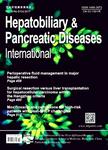Management of the middle hepatic vein and its tributaries in right lobe living donor liver transplantation
Management of the middle hepatic vein and its tributaries in right lobe living donor liver transplantation作者机构:Zhejiang Univ Sch Med Affiliated Hosp 1 Dept Hepatobiliary Surg Hangzhou 310003 Peoples R China
出 版 物:《Hepatobiliary & Pancreatic Diseases International》 (国际肝胆胰疾病杂志(英文版))
年 卷 期:2007年第6卷第4期
页 面:358-363页
核心收录:
学科分类:1002[医学-临床医学] 100210[医学-外科学(含:普外、骨外、泌尿外、胸心外、神外、整形、烧伤、野战外)] 10[医学]
基 金:This study was supported by a grant from the National Key Basic Research Program (973) of China (No. 2003 CB515501) Important Project from Science and Technology Department of Zhejiang Province (No. 021103699)
主 题:right lobe living donor liver transplantation middle hepatic vein vein graft hepatic venoplasty
摘 要:BACKGROUND: Left liver graft from a small donor will not meet the metabolic demands of a larger adult recipient. To overcome the problem of graft size insufficiency, living donor liver transplantation (LDLT) using the right lobe has become a standard method for adult patients. As the drainage of the median sector (segments V, VIII and IV) is mainly by the middle hepatic vein (MHV), the issue of whether the MHV should or should not be taken with the graft or whether the MHV tributaries (V5, V8) should be reconstructed in the recipient remains to be settled. DATA SOURCES: An English-language literature search was conducted using MEDLINE (1985-2006) on right lobe living donor liver transplantation, middle hepatic vein, vein graft, hepatic venoplasty and other related subjects. RESULTS: Some institutions had proposed their policy for the management of the MHV and its tributaries. Dominancy of the hepatic vein, graft-to-recipient weight ratio, and remnant liver volume as well as the donor-to-recipient body weight ratio, the volume of the donor s right lobe to the recipient s standard liver volume and the size of MHV tributaries are the major elements for the criteria of inclusion of the MHV, while for the policy of MHV tributaries reconstruction, the proportion of congestive area and the diameter of the tributaries are the critical elements. Optimal vein grafts such as recipient s portal vein and hepatic venoplasty technique have been used to obviate hepatic congestion and venous drainage disturbance. CONCLUSIONS: Taking right liver grafts with the MHV trunk (extended right lobe grafts) or performing the MHV tributaries reconstruction in modified right lobe grafts, according to the criteria proposed by the institutions with rich experience, can solve the congestion problem of the right paramedian sector and help to improve the outcomes of the patients. The additional use of optimal vein grafts and hepatic venoplasty also can guarantee excellent venous drainage.



